Engineering Grad Students Introduce High Schoolers to Engineering Via IRISE
May 10, 2017
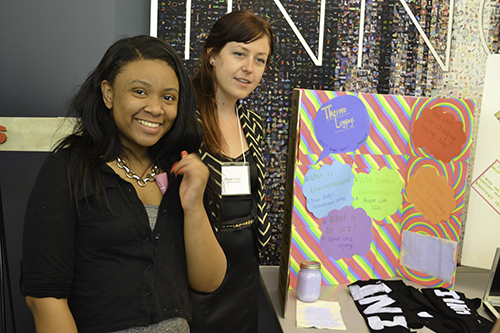
A Centennial High student and her grad student mentor, Bridget Curren, present during the IRISE Symposium poster session.
In spring 2017, IRISE (the Illinois partnership for Respecting the Identities of Students in Engineering) connected Illinois Engineering graduate students in the ME598EO course with local ninth-graders from Centennial High School’s AVID program. The goal was to use engineering to provide a solution to a problem in our local community. So the students sought to address obstacles athletes in the Illini Wheelchair Basketball Program encounter while training, competing, or just in everyday life. Not only did the grad students learn a lot about outreach; the high school students learned a bit about what engineers do, and a few even discovered that they might like to become one.
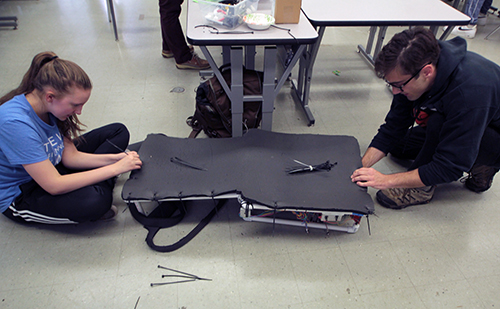
A Centennial student (left) and her Illinois grad student mentor (right) work on her team's project (image courtesy of Joe Muskin).
Taught by Mechanical Science & Engineering (MechSE) Visiting Faculty, Sharlene Denos, Assistant Professor Elif Ertekin, and Education Outreach Coordinator, Joe Muskin, ME598, Sustainable Engineering Outreach, 1) made 16 Engineering grad students aware of issues of power, privilege, and identity related to STEM education and outreach; 2) exposed them to the benefits, challenges, and rewards of engineering educational outreach; then 3) gave them the opportunity to put into practice what they’d learned with some local high school students. Revamped from an IRISE ME598 course Denos taught several years ago, the course was funded through Elif Ertekin’s NSF Career grant. The curriculum for the course was based on a curriculum that Denos and a colleague, Dominique Arnold, who teaches a course on Race, Power, and Identity in Educational Psychology, developed for an interdisciplinary unit on race and racism at Uni High.
Denos, who wrote the original I-RISE proposal and developed the course, which she had taught three times previously, says that the first iteration was “fairly traditional in terms of the types of outreach experiences we were involved with and the training that happened.” As a result, “Many of the students were not well equipped to work with diverse students,” she acknowledges.
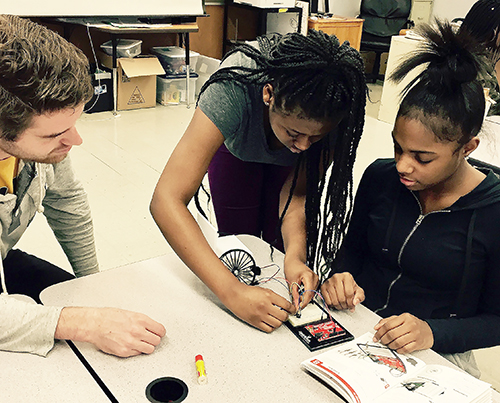
An Illinois grad student (left) watches as the students he's mentoring work on their final project. (Photo courtesy of Joe Muskin.)
So according to Denos, the goal this time around was “to provide some training for the graduate students in terms of...how does your identity, how does your power and privilege play into the way you interact with the kids and the teachers—the way you learn, the way they learn, and the way you come together to create something?” In addition, they made it a mentoring program. “We were very explicit in making the relationships the most important piece of the program,” she explains.
Along with grad students, the rejuvenated IRISE program also targeted K–12 students, specifically Lindsay Aikman’s AVID classes at Centennial High School in Champaign. AVID (Advancement Via Individual Determination) is a global, nonprofit organization whose mission is to “close the achievement gap by preparing all students for college readiness and success in a global society.”
Denos adds that in Culturally Responsive Teaching, which the course sought to implement, it’s absolutely crucial that the teacher adopt the philosophy that the kids are fine just the way they are. “The kids are not only fine, but they bring to the table quite a lot,” Denos explains.
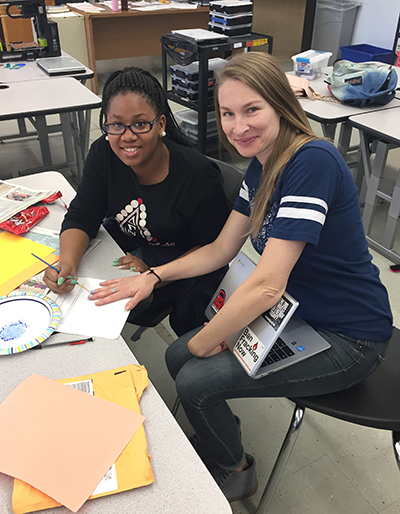
A Centennial student paints her teacher's nails with thermochromic paint they used in their project (image courtesy of Joe Muskin).
So the focus of I-RISE’s outreach program is to not only encourage the students to bring themselves, their identity, and who they are into these engineering experiences, “But the kids’ identities are central, important, and necessary in order for these engineering projects to be successful,” Denos says. “So, they’re leveraging things that previously they have been told aren’t relevant or aren’t useful or aren’t valuable in an engineering context, and we’re telling them ‘No, actually it is!’”
Denos shares an anecdote about a group of students whose project involved using thermochromic paint (which changes color when the temperature changes) on leggings. "That really came from the kids," Denos explains. Because the grad student, Bridget Curren, knew the kids she was mentoring were into fashion, she mixed thermochromic paint into nail polish and brought it in to class.
"The next thing you know," Denos continues, "the girls were all there painting their nails, and they would put their hand on it, and they would see that it would change color, and then it just kind of clicked. Then they could really realize that something that they like, something that was really relevant and important to them, was also important in an engineering context...With the leggings they got to choose the look of the leggings and that’s something they can bring, ideas about fashion. That’s generally not accepted or seen as valuable in science class, but in this context it was valuable.”
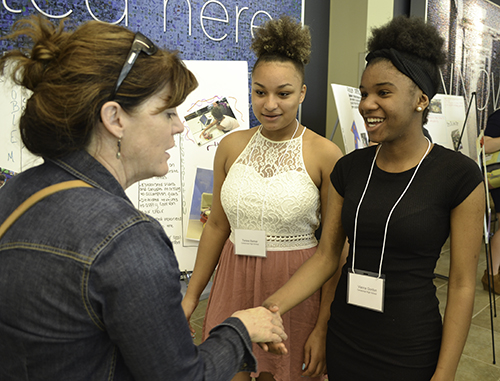
Two Centennial students interact with an Illinois researcher during the symposium.
To celebrate the achievements of Centennial’s IRISE Engineering Scholars, the IRISE 2017 Symposium was held at NCSA on May 9th. A lunch reception and the students’ poster presentations were followed by a video highlighting IRISE’s program in 2017, a keynote by Illinois Wheelchair Basketball Coach Matt Buchi, and recognition of Centennial’s IRISE Engineering Scholars.
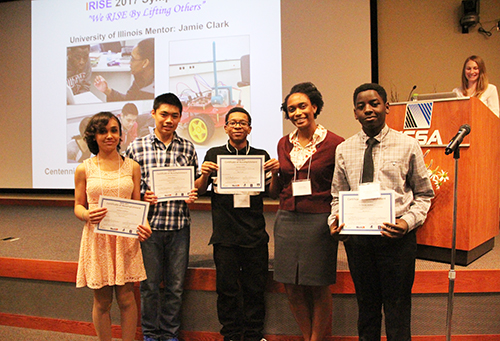
A team of Centennial students pose with the certificates they have just received during the symposium (image courtesy of Joe Muskin).
Key to IRISE’s outreach to the high schoolers were the Engineering grad students, for whom Ertekin had high praise, calling them “amazing...really dedicated and really committed.” But while the grad students gave a lot through the program, the also gained a lot in return. For instance, Ertekin believes they discovered the importance of becoming engaged in their community.
“I think it’s really important for the graduate students to be a part of that outreach in ways that are really meaningful and impactful,” Ertekin explains. “And I think that the graduate students have had the opportunity to be able to see that everybody in the community can be excited about STEM-related work. You work together as a team on projects, and make complex engineering accessible to young students, everybody gets excited. And I think that’s been a very valuable lesson for the graduate students.”
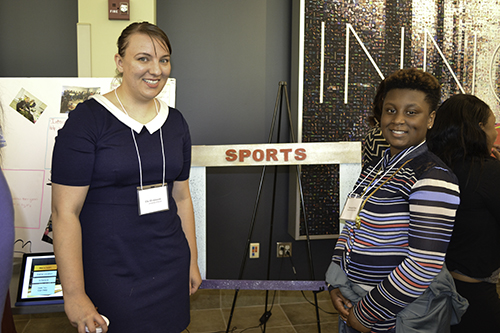
Aerospace Engineering grad student Elle Wroblewski (left) and one of the Centennial High students she worked with.
Take ME598 scholar Elle Wroblewski, an Aerospace Engineering grad student. No rookie when it comes to outreach, she's heavily involved with the Illini Aerospace Outreach, which mostly works with elementary students. Wroblewski had two very specific goals in taking the course:
“This class was an opportunity to 1) work with high schoolers, which is an age range we don’t normally reach, and 2) to learn about why outreach is so important as opposed to my preconceived notions as to why it’s important. So that’s been really valuable, getting to understand outreach and education from the perspective of educators, because I’m not; I’m an engineer. So I don’t know anything about education.”
What did she learn in the course? “I learned a lot about culture,” she admits, “and how that applies to education…like why it’s important for me to know history, and understand psychology, and understand a lot of stuff beyond engineering in order to teach engineering, and I think that’s been the biggest take-away.”
Another grad student, Malia Kawamura, who’s involved with the ENVISION grad student outreach group, shares why she took the class: “I really enjoy doing outreach, and I wanted to learn how I could do it better.”
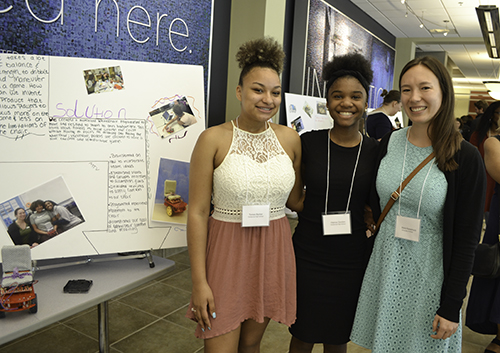
Engineering grad student Malia Kawamura (right), and two of the Centennial students she mentored.
Kawamura says she learned a lot. “I learned that the personal connection and the relationships you build can lead to the largest impact,” she says. Something else she learned? “Making sure that the type of outreach you’re doing is relevant to the populations you’re working with is very important.”
Kawamura also learned about how different social justice issues are related to engineering and education in general: “Urban planning, and how that affects education, and undocumented immigrants, and race and racism, and how all those things factor in...the students you might be working with—that’s part of their lives. Knowing more about people wholistically helps you do a better job connecting with them.”
She also learned why increasing diversity in STEM is such a hot topic: “The types of engineering and science problems we’re trying to solve now are getting more and more complex, and we really need more diverse students and more diverse people involved…So we’ve done it the same way with the same people included for a while now, and we can do better.”
She also learned that changing the way things are taught can have an impact. “People can get into a deficit mindset thinking about achievement gap, but the focus should really be on how the outreach we’re doing and the education can better connect with those populations rather than trying to change the students to fit within what might be considered a standard education classroom.”
While the grad students learned a lot through their class, the high school students learned a lot too. For example, Ertekin believes that the opportunity helped the high schoolers learn what engineering really is.
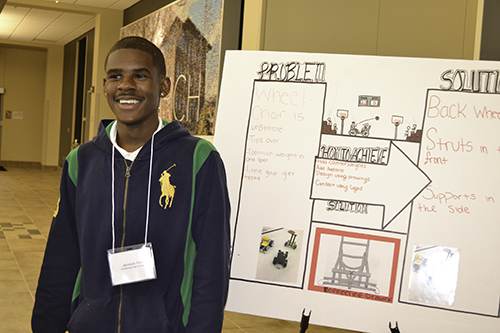
A Centennial student presents his research to visitors during the symposium.
“I believe that every one of those kids has an engineer inside, and whatever they choose to do in their lives, they’ll be very successful at. And I hope that this has opened some of their eyes to what it is that engineers actually do, because I think that can be sometimes mysterious to younger kids, and it’s really valuable to be able to kind of demystify that and show them concretely, ‘Hey, this is the way that engineers have impact in the world,’ and then make them feel like they’re part of that process.”
Wroblewski says she thinks the high schoolers also learned that engineers are real people, just like them.
“I think that their biggest take-away has been seeing engineers, and understanding that it’s an option, and getting to engage with us as people. I feel like some kids, maybe they think that they have to be super, extra good at math. And I think it helps for them to meet us and to engage with us over the course of the semester, to really make it be more like, ‘Everybody can do it. You can do it.’ It makes it more personal, I guess.”
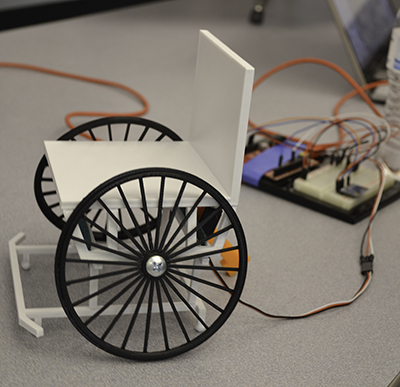
A prototype one team of Centennial students built.
Kawamura shares an anecdote about the first time she brought an arduino in:
“One of my students was like, ‘I don’t know how to do this! I don’t know how to build a sensor to make this work!’ Then I was like, ‘Ok, just give it a try. I’ll help you.’ Oh, she just jumped right into it, and she figured it out so fast! And when she built the sensor, she was like, ‘Miss Aikman! Miss Aikman!’ She wanted to show her."Kawamura reports how rewarding it was to see the students she was mentoring grow in confidence and learn that they could indeed do engineering. So it was really fun watching them be hesitant to start, and then as soon as they started, they picked everything up so fast! It was so fun working with them and watching them learn so quickly. And I had to keep bringing in more challenging things, because the more challenging it was, the more engaged they were learning new things.”
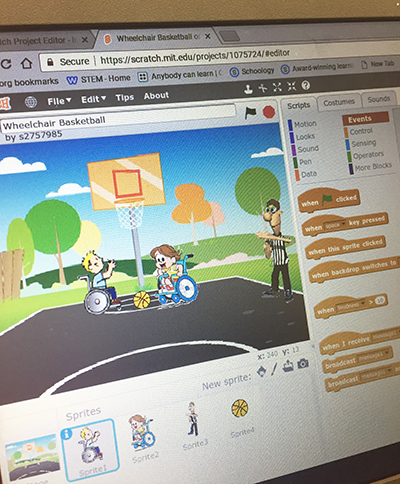
The wheelchair basketball game one team of Centennial students buil on Scratch (image courtesy of Joe Muskin).
Denos shares another anecdote about a team of students who were designing a wheelchair basketball game. There was a glitch, and they lost all of the work they had done. "So they were really frustrated, and they thought they would have nothing to show, and they were really sad about that," shares Denos. Their grad student mentor had said "Look, fine, I’ll go ahead and fix it." But it turns out that when he logged back in to fix it, "The kids had gone in and redone the whole game and fixed everything, and it was all done," Denos says. "It was something they did on their own time." She explains that It wasn’t a homework assignment or something they were getting graded for; they had already received all of their points. "But the kids felt that they had ownership over it. It was their project, and they got to choose how the characters looked, and what they said, and the rules of the game."
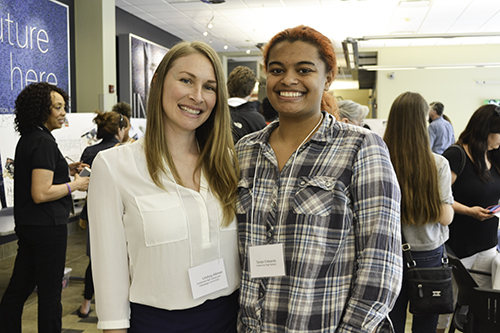
Centennial High AVID teacher Lindsay Aikman (left) and one of her students during the IRISE Symposium.
Lindsay Aikman, Centennial’s 9th grade AVID teacher, is trained as an English teacher, but there she was, helping her kids through the engineering project. Did she learn some stuff about engineering too during the program?
“I did, and I wish I would have had this opportunity when I was their age, because perhaps I could have considered this field.”
Aikman believes her students learned a lot about engineering through the program. "You know, I think this has done a good job of demystifying the engineering field, and showing that it can be a lot more accessible than people realize. It’s really about designing a product and developing a solution to a problem that you see in the world and developing that solution.
Does Aikman believes the program influenced some of her students to seriously consider careers in engineering? “Oh, yes,” she reports, “and in surprising ways! I have a student who has all along said she wanted to go as an OBGYN, and now, through this, it has been revealed that she has an intuition for programming. So we’re going to try to get her into summer programming camp on the engineering campus. I have other students who have never considered engineering at all, and are now attending engineering summer camps for a week in the summer.”
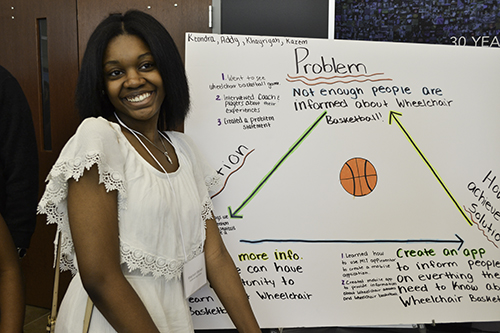
Centennial High student Khayriyah Mitchell.
One of Aikman’s students for whom the IRISE engineering class had a significant impact was freshman Khayriyah Mitchell.
“It was a great experience,” she reports. “AVID just gives me an earlier view, because I’m a freshman, of college, and how college works, and I appreciate that. And the IRISE program, it opens me up to engineering and it gives me a better understanding of what engineering is. I didn’t really see myself as an engineer, but I actually do now.”
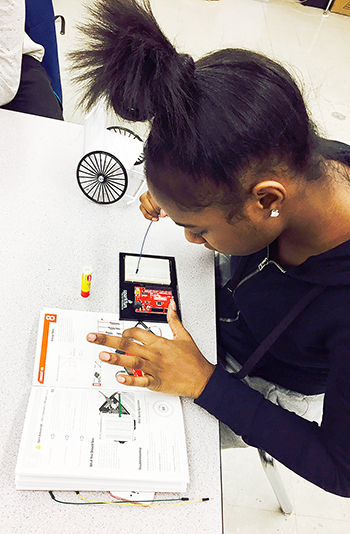
Centennial High student Khayriyah Mitchell (image courtesy of Joe Muskin).
In fact, Khayriyah plans to go to two camps this summer—one will be MechSE's engineering camp for high school girls: G-BAM GAMES camp.
“Building our apps, making our posters, meeting new people on campus gave me a better look on how college works,” she continues, “and it excites me to actually be an engineer!”
Story and photos by Elizabeth Innes, Communications Specialist, I-STEM Education Initiative.
For more I-STEM stories about IRISE, see:
- iRISE Course Prepares Engineers for Community Outreach
- iRISE and Denos Work to Get Students Hooked on Science in Middle School
- Physics Center Rises to the Challenge: iRISE Makes Learning Science Fun
More: Centennial, Graduate Education Reform, iRISE, Underserved Minorities, 2017
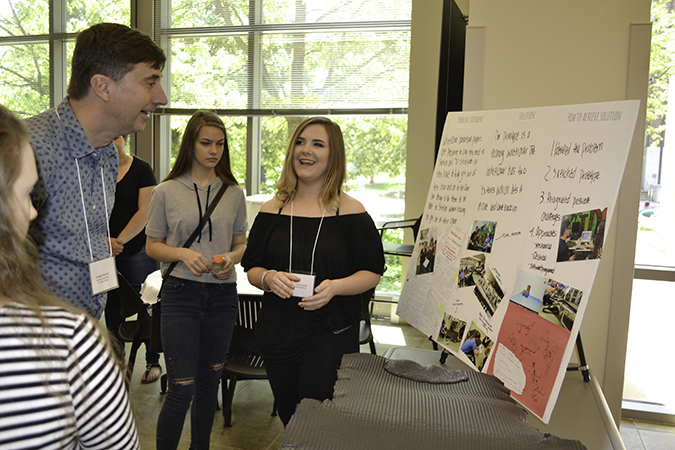
MechSE's Joe Muskin (upper left) interacts with a Centennial student as she explains about her team's research.
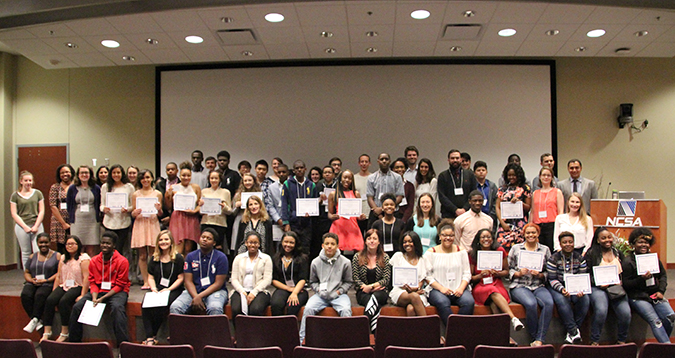
A group photo of the spring 2017 I-RISE participants (image courtesy of Joe Muskin).